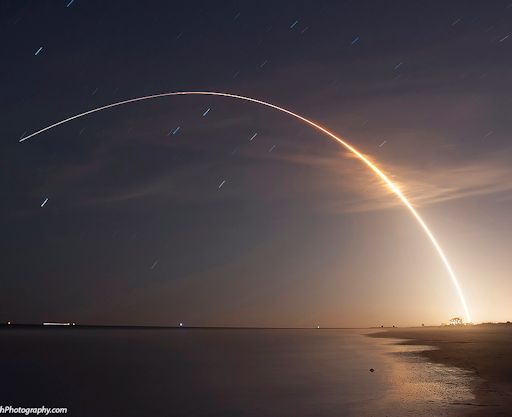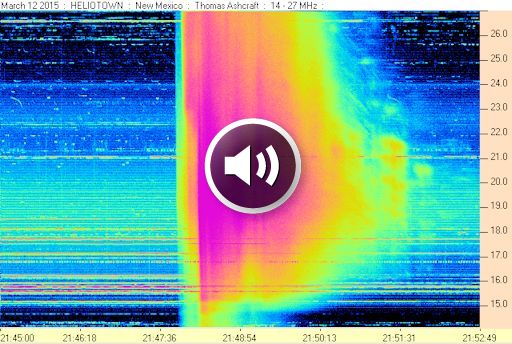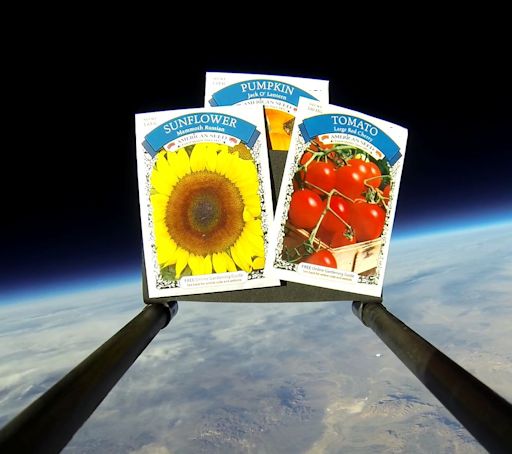Learn to photograph Northern Lights like a pro. Sign up for Peter Rosen's Aurora Photo Courses in Abisko National Park. | | |
CHANCE OF STORMS: Friday the 13th could be a lucky day for sky watchers. Several minor CMEs propelled toward Earth earlier this week by active sunspot AR2297 are expected to arrive en masse on March 13th. Their collective impact could spark bright auroras around the Arctic Circle. NOAA forecasters estimate a 65% chance of G1-class geomagnetic storms when the CMEs arrive. Aurora alerts: text, voice
IMPORTANT SPACE WEATHER LAUNCH: Why do solar flares explode? Last night, NASA launched a fleet of spacecraft to answer that question. Blasting off from Cape Canaveral, the four probes of the Magnetospheric Multiscale (MMS) mission will spend the next 2 years flying in formation around Earth. Their mission: to study magnetic reconnection, the mysterious process that powers solar flares and geomagnetic storms. Photographer Ben Cooper watched the rocket roar into space from a remote viewing site in the Ponce de Leon Inlet, Florida:

"The Atlas 5 rocket streaked into the sky with NASA's four Magnetospheric Multiscale probes," says Cooper. "It was a beautiful view 40.7 miles north of launch Complex 41."
Shortly after launch, the rocket experienced an outgassing event. The resulting spherical cloud, which some observers are calling the "MMS Nebula" was visible to the naked eye as far away as Texas. Bryan Tobias of San Antonio took this picture from his front yard. Ed Cannon of Austin, Texas, says "it was about twice the size of the full Moon, generally circular, and very easy to see without any magnification. About two minutes later it had grown in size to several degrees in length." What created this cloud? A post on the NASA Spaceflight forum suggests that it may have been fumes from reaction control thrusters, which helped the MMS probes spin up just before deployment.
More photos of the launch and the MMS Nebula may be found in the realtime photo gallery:
Realtime Space Weather Photo Gallery
SOLAR RADIO BURST: For much of the week, space weather news has focused on how sunspot AR2297 is causing radio blackouts on Earth. On March 12th the sunspot did the opposite. It unleashed a shortwave radio burst. "It was super intense--one of the strongest bursts of the current solar cycle," reports amateur radio astronomer Thomas Ashcraft. Click on the image below to play a recording of the sounds he heard issuing from the loudspeaker of his radio telescope in rural New Mexico:

"The recording starts a little rough for a few seconds in that there was a ham transmission in progress on one channel (22 MHz) and the other channel (23 MHz) had a tiny bit of buzz," says Ashcraft. "But then the solar burst hit and the ham voices were entirely drowned out. For the next 3 minutes, the airwaves were dominated by solar static."
These radio sounds are caused by beams of electrons--in this case, accelerated by an M4-flare. As the electrons slice through the sun's atmosphere, they generate a ripple of plasma waves and radio emissions detectable on Earth 93 million miles away. Astronomers classify solar radio bursts into five types; Ashcraft's recording captured a mixture of Type III and Type V.
More bursts are in the offing. AR2297 has an unstable 'beta-gamma-delta' magnetic field that harbors energy for 'radio-active' explosions. NOAA forecasters estimate a 70% chance of M-class flares and a 20% chance of X-flares on March 13th. Solar flare alerts: text, voice
Realtime Space Weather Photo Gallery
SPACE SEEDS: In late February, the students of Earth to Sky Calculus conducted an experiment in "space agriculture." Using a sub-orbital helium balloon, they flew a dozen varieties of garden vegatables and flowers to the edge of space. Here are three of the seed packets photographed at an altitude of 112,030 feet:

During their ascent to the stratosphere, these seeds (and 80 other packets not shown) experienced temperatures as low as -63 C, air pressures akin to those on the planet Mars, and cosmic ray dose rates 40x Earth-normal. While these "space seeds" were flying to the edge of space, identical control samples remained behind on Earth.
Students intend to plant the flown seeds side-by-side with control samples to investigate whether near-space travel affects the viability, color, size, taste or other characteristics of the plants.
Readers, would you like to grow your own space garden? For a small donation of $49.95 to Earth to Sky Calculus, you can have some of these space seeds for yourself. They make a great science fair project and, possibly, a unique meal! You may chose any two seed types from the following list: turnips, cherry tomatoes, beefsteak tomatoes, sweet corn, green beans, bell peppers, helichrysum flowers, jalapeno peppers, petunias, radishes, sunflowers, cosmos flowers, pumpkins, broccoli and carrots. We will send you flown+control packets for both of your selections. Contact Dr. Tony Phillips to place your order. All proceeds support student research.
Realtime Comet Photo Gallery
Realtime Aurora Photo Gallery
Every night, a network of NASA all-sky cameras scans the skies above the United States for meteoritic fireballs. Automated software maintained by NASA's Meteoroid Environment Office calculates their orbits, velocity, penetration depth in Earth's atmosphere and many other characteristics. Daily results are presented here on Spaceweather.com.
On Mar. 13, 2015, the network reported 6 fireballs.
(6 sporadics)

In this diagram of the inner solar system, all of the fireball orbits intersect at a single point--Earth. The orbits are color-coded by velocity, from slow (red) to fast (blue). [Larger image] [movies]
Potentially Hazardous Asteroids (
PHAs) are space rocks larger than approximately 100m that can come closer to Earth than 0.05 AU. None of the known PHAs is on a collision course with our planet, although astronomers are finding
new ones all the time.
On March 13, 2015 there were potentially hazardous asteroids.
Notes: LD means "Lunar Distance." 1 LD = 384,401 km, the distance between Earth and the Moon. 1 LD also equals 0.00256 AU. MAG is the visual magnitude of the asteroid on the date of closest approach. | | The official U.S. government space weather bureau |
| | The first place to look for information about sundogs, pillars, rainbows and related phenomena. |
| | Researchers call it a "Hubble for the sun." SDO is the most advanced solar observatory ever. |
| | 3D views of the sun from NASA's Solar and Terrestrial Relations Observatory |
| | Realtime and archival images of the Sun from SOHO. |
| | from the NOAA Space Environment Center |
| | the underlying science of space weather |

